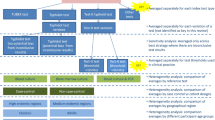Abstract
We developed a content validated computerized epilepsy treatment clinical decision support system to assist clinicians with selecting the best antiepilepsy treatments. Before disseminating our computerized epilepsy treatment clinical decision support system, further rigorous validation testing was necessary. As reliability is a precondition of validity, we verified proof of reliability first. We evaluated the consistency of the epilepsy treatment clinical decision support system in three areas including the preferred antiepilepsy drug choice, the top three recommended choices, and the rank order of the three choices. We demonstrated 100 % reliability on 15,000 executions involving a three-step process on five different common pediatric epilepsy syndromes. Evidence for the reliability of the epilepsy treatment clinical decision support system was essential for the long-term viability of the system, and served as a crucial component for the next phase of system validation.


Similar content being viewed by others
References
Hauser, W. A., and Hesdorffer, D. C., Epilepsy: Frequency, causes and consequences. Demos, New York, 1990.
Linehan, C., and Berg, A., Epidemiologic aspects of epilepsy. In: Wyllie, E., Cascino, G. D., Gidal, B. E., and Goodkin, H. P. (Eds.), Wyllie’s Treatment of Epilepsy: Principles and Practice, 5th edition. Lippincott, Williams & Wilkins, Philadelphia, pp. 2–10, 2011.
Iyer, R. S., Mangattuthodi, R., Kumar, T. S., Sarma, P. S., and Radhakrishnan, K., Primary care doctors’ management behavior with respect to epilepsy in Kerala, southern India. Epilepsy Behav 21:137–142, 2011.
Smith, R., Filling the lucana between research and practice: an interview with Michael Peckham. Brit Med J 307:1403–1407, 1992.
Rosenberg, W., and Donald, A., Evidence based medicine: an approach to clinical problem solving. Brit Med J 310:1122, 1995.
Pestian, J., Matykiewicz, P., Spencer, M., Holland, K., Standridge, S., Byadarhaly, K., and Glauser, T., Selecting anti-epileptic drugs: A pediatric epileptologist’s view, a computer’s view. Acta Neurol Scand 127:208–15, 2013.
Roundtable on evidence-based medicine, Institute of Medicine. Olsen L, Aisner D, McGinnis JM, The learning healthcare system: workshop summary, p 5. National Academies Press, Washington, DC, 2007.
Reeve, H., Baxter, K., Newton, P., Burkey, Y., Black, M., and Roland, M., Long-term follow-up in outpatient clinics: The view from general practice. Fam Pract 14:24–8, 1997.
Austin, S. M., Balas, E. A., Mitchell, J. A., and Ewigman, B. G., Effect of physician reminders on preventive care: meta-analysis of randomized clinical trials. Proc Annu Symp Comput Appl Med Care, In, pp. 121–124, 1994.
Sim, I., Gorman, P., Greenes, R. A., Haynes, R. B., Kaplan, B., Lehmann, H., and Tang, P. C., Clinical decision support systems for the practice of evidence-based medicine. J Am Med Inform Assoc 8:527–534, 2001.
Garg, A. X., Adhikari, N. K., McDonald, H., Rosas-Arellano, M. P., Devereaux, P. J., Beyene, J., Sam, J., and Haynes, R. B., Effects of computerized clinical decision support systems on practitioner performance and patient outcomes a systematic review. JAMA 293:1223–1238, 2005.
Teich, J. M., Osheroff, J. A., Pifer, E. A., Sittig, D. F., and Jenders, R. A., Clinical decision support in electronic prescribing: recommendations and an action plan: report of the joint clinical decision support workgroup. J Am Med Inform Assoc 12:365–76, 2005.
Committee on Quality of Healthcare in America, Institute of Medicine. Kohn LT, Corrigan JM, Donaldson MS (eds.) (2000) To err is human: building a safer health system, pp 57–62. National Academies Press, Washington, DC
Berner, E. S., Clinical decision support systems: State of the Art, In the Agency for Healthcare Research and Quality. Rockville, Maryland, 2009.
Pestian, J., Spencer, M., Matykiewicz, P., Zhang, K., Vinks, A. A., and Glauser, T., Personalizing drug selection using advanced clinical decision support. Biomed Inform Insights 23:19–29, 2009.
Drug-Drug Interaction Database (Medispan). Philadelphia, PA, Wolters Kluwer Health. 2005. http://www.medispan.com/drug-information-bridge/. Accessed February 2008.
Commission on Classification and Terminology of the International League Against Epilepsy, Proposal for revised classification of epilepsies and epileptic syndromes. Epilepsia 30:389–399, 1989.
Arzimanoglou, A., Guerrini, R., and Aicardi, J., Aicardi’s Epilepsy in Children. Lippincott, Williams, and Wilkins, Philadelphia, 2004.
Hauser, W. A., The prevalence and incidence of convulsive disorders in children. Epilepsia 2(Suppl 35):1–6, 1994.
Selenium – Web Browser Automation: [computer program]. Version 2.38. http://www.seleniumhq.org/;
Kunhimangalam, R., Ovallath, S., and Joseph, P. K., A Clinical Decision Support System with an Integrated EMR for Diagnosis of Peripheral Neuropathy. J Med Syst 38:38, 2014.
Suganthi, M., and Madheswaran, M., An improved medical decision support system to identify the breast cancer using mammogram. J Med Syst 36:79–91, 2012.
Rodríguez-González, A., Labra-Gayo, J. E., Colomo-Palacios, R., Mayer, M. A., Gómez-Berbís, J. M., and García-Crespo, A., SeDeLo: Using semantics and description logics to support aided clinical diagnosis. J Med Syst 36:2471–2481, 2012.
Shirabad, J. S., Wilk, S., Michalowski, W., and Farion, K., Implementing an integrative multi-agent clinical decision support system with open source software. J Med Syst 36:123–137, 2012.
Mills, J., Meltzer, R., and Clark, M., Effect of number of options on recall of information supporting different decision strategies. Person Soc Psychol Bull 3:213–218, 1977.
Roller C (2010) Abundance of choice and its effect on decision making. http://www.uxmatters.com/mt/archives/2010/12/abundance-of-choice-and-its-effect-on-decision-making.php. Accessed 28 December 2013
Kawamoto, K., Houlihan, C. A., Balas, E. A., and Lobach, D. F., Improving clinical practice using clinical decision support systems: a systematic review of trials to identify features critical to success. Brit Med J 330:740–1, 2005.
Author information
Authors and Affiliations
Corresponding author
Additional information
This article is part of the Topical Collection on Transactional Processing Systems.
Rights and permissions
About this article
Cite this article
Standridge, S., Faist, R., Pestian, J. et al. The Reliability of an Epilepsy Treatment Clinical Decision Support System. J Med Syst 38, 119 (2014). https://doi.org/10.1007/s10916-014-0119-9
Received:
Accepted:
Published:
DOI: https://doi.org/10.1007/s10916-014-0119-9




